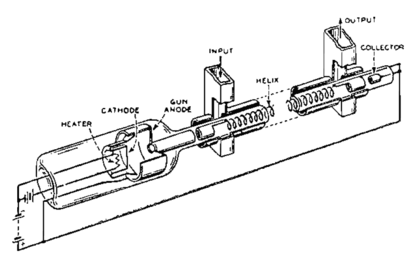

A traveling-wave tube (TWT, pronounced "twit"[1]) or traveling-wave tube amplifier (TWTA, pronounced "tweeta") is a specialized vacuum tube that is used in electronics to amplify radio frequency (RF) signals in the microwave range.[2] It was invented by Andrei Haeff around 1933 as a graduate student at Caltech, and its present form was invented by Rudolf Kompfner in 1942–43. The TWT belongs to a category of "linear beam" tubes, such as the klystron, in which the radio wave is amplified by absorbing power from a beam of electrons as it passes down the tube.[2] Although there are various types of TWT, two major categories are:[2]
- Helix TWT - in which the radio waves interact with the electron beam while traveling down a wire helix which surrounds the beam. These have wide bandwidth, but output power is limited to a few hundred watts.[3]
- Coupled cavity TWT - in which the radio wave interacts with the beam in a series of cavity resonators through which the beam passes. These function as narrowband power amplifiers.
A major advantage of the TWT over some other microwave tubes is its ability to amplify a wide range of frequencies i.e. a large bandwidth. The bandwidth of the helix TWT can be as high as two octaves, while the cavity versions have bandwidths of 10–20%.[2][3] Operating frequencies range from 300 MHz to 50 GHz.[2][3] The power gain of the tube is on the order of 40 to 70 decibels,[3] and output power ranges from a few watts to megawatts.[2][3]
TWTs are widely used as the power amplifiers and oscillators in radar systems, communication satellite and spacecraft transmitters, and electronic warfare systems.[2]

- ^ Electronics World + Wireless World. Reed Business Pub. 1991. p. 66.
- ^ a b c d e f g Gilmour, A. S. (2011). Klystrons, Traveling Wave Tubes, Magnetrons, Crossed-Field Amplifiers, and Gyrotrons. Artech House. pp. 317–18. ISBN 978-1608071852.
- ^ a b c d e Whitaker, Jerry C. (2002). The RF Transmission Systems Handbook. CRC Press. pp. 8.14–8.16. ISBN 1420041134.